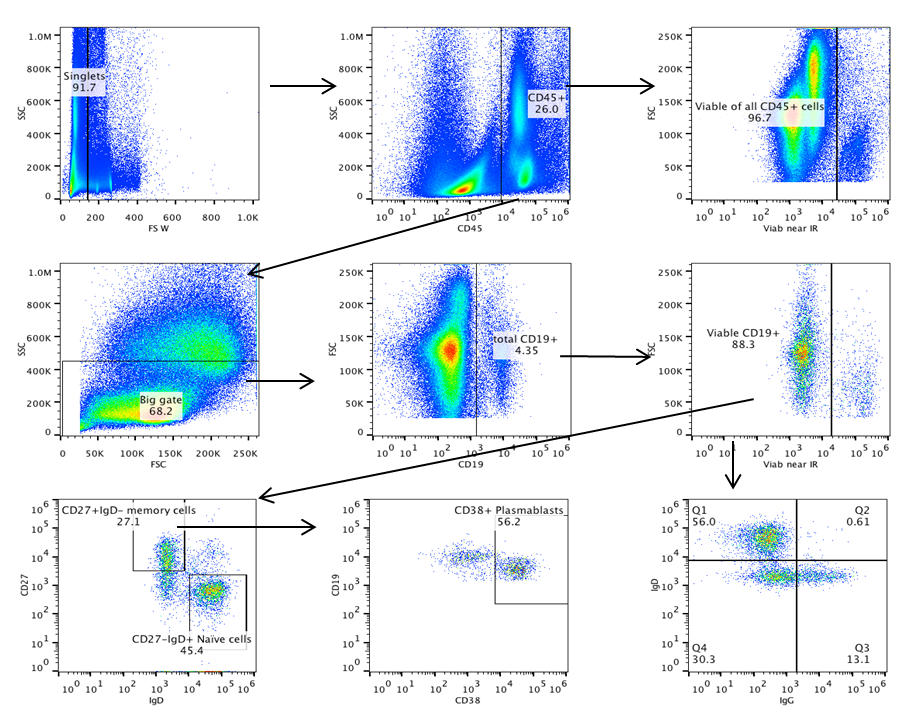B cell assay
In SLE and other systemic autoimmune diseases, B cells is one cell type which plays a central role in the pathology (Wahren-Herlenius, Lancet 2013) by the production of autoantibodies directed to nucleic acid-associated autoantigens (histones, ribonucleoprotein). These autoantibodies can form immune complexes, which can drive inflammation in part through interferon type I induction. The interferogenic immune complexes can activate plasmacytoid dendritic cells (Rönnblom, Lupus 2008) after internalisation initiated by binding the FcgRIIa receptor. Interferon release is induced by subsequent binding of the nucleic acid included in the immune complex to intracellular toll-like receptors. B cells can also function as antigen-presenting cells and thus perpetuate T cell driven immune responses, as well as produce proinflammatory cytokines.
To investigate primary B cell maturation, IgG and IgM secretion and cell viability in presence of well defined chemical inhibitory probes and compounds.
We have identified 18 chemical probes and compounds with inhibitory function of defined proteins that suppress B cell maturation and IgG secretion. These probes and compounds bind and inhibit the function of WDR5, EZH2, G9a, PRMT5, BET, MEK1, STK16, SMYD2, MTHFD2, DHFR, DNA, DHODH and FAS. Further validation such as probes’ effects on target proteins and cellular pathways affected will be performed.
Note: Results using negative control compounds indicate that G9a and EZH2 are not likely primary targets mediating the effect observed (verification studies ongoing).
General protocol: PBMC (Peripheral Blood Mononuclear Cells) are cultured for 6 days under B cell maturing conditions. The effect on B cell maturation upon addition of chemical probes is investigated by flow cytometry and by ELISA measuring IgG and IgM in cell supernatants. Viability of cells is assayed by flow cytometry or CellTiter-Glo.
Cell culture condition: Cell are cultured at 1 million PBMC/ml, 200µl/well, in triplicates. Culture medium is RPMI supplemented with 10% heat inactivated bovine serum. Probe is added at start of culture. No medium replenishment or probe addition is done during day 1-6. Controls include unstimulated condition (cell culture medium without added cytokines), stimulated condition with vehicle control only (DMSO), stimulated condition with the Jak inhibitor Tofacitinib.
Readout: Flow cytometry is done on freshly isolated PBMC and at end of culture, and include markers for cell viability, CD45, CD19, CD27, IgD, IgG, CD38 (Screen 1). Secreted IgG and IgM in supernatant from day 6 is measured by ELISA (Screen 1 and 2). Viability of cells is measured at end of culture, either by flow cytometry (Screen 1) or CellTiter-Glo (Screen 2).
Flow cytometry
Gating strategy. Leukocytes were identified by analysing singlet cells (based on FSW vs SC) expressing CD45. The viability of these cells was analysed using a dead cell dye. Leukocytes were further divided into lymphocytes by FSC vs SSC, and B cells by CD19 staining. B cell viability was analysed. Live B cells were divided into naïve CD27-IgD+ B cells and memory CD27+IgD- B cells, as well as by cell surface expression of IgG. Memory B cells were further divided in CD38+ plasmablasts.
The study was approved by the Regional Ethical Review Board in Stockholm, approval number 2015/2001-31/2.
Results Screen 1
A set of 43 probes were tested in 20 blood donors including 5 patients with systemic lupus erythemtosus (SLE), 7 with idiopathic inflammatory myositis (IIM) and 7 healthy donors. The effect on PBMC IgG secretion and maturation/viabiliby of B cells on day 6 of cell culture in presence of B cell stimulating agents are expressed normalized to the vehicle control (0,01% DMSO).

Each panel represents a different assay readout with shading scaled separately for each assay panel. HC = Healthy Controls, SLE = SLE Patients, IIM = IIM Patients. Readouts have been averaged across donor groups. More information on the SGC chemical probes can be found here: http://www.thesgc.org/chemical-probes
9 of the 43 tested chemical probes resulted in reduction of IgG secretion without overt cell death. Detailed results of these 9 probes as well as of the JAK 1/3 inhibitor Tofacitnib used as a positive control is given in figure 2. Data is expressed normalised to vehicle control: a) the effect of secreted IgG on day 6 of cell culture b) the effect on the percent of B cells of total live CD45+ lymphocytes on day 6 of cell culture, c) the effect on the percent of CD27+IgD- memory B cells of total live B cells on day 6 of cell culture.
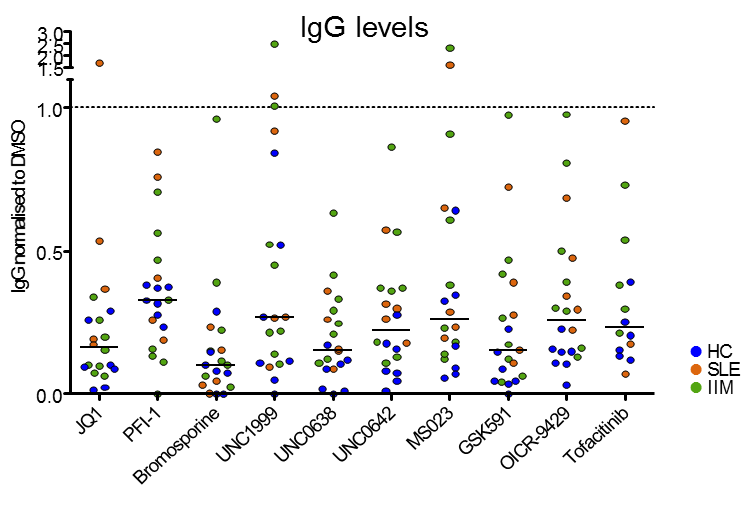 Fig 2a IgG levels |
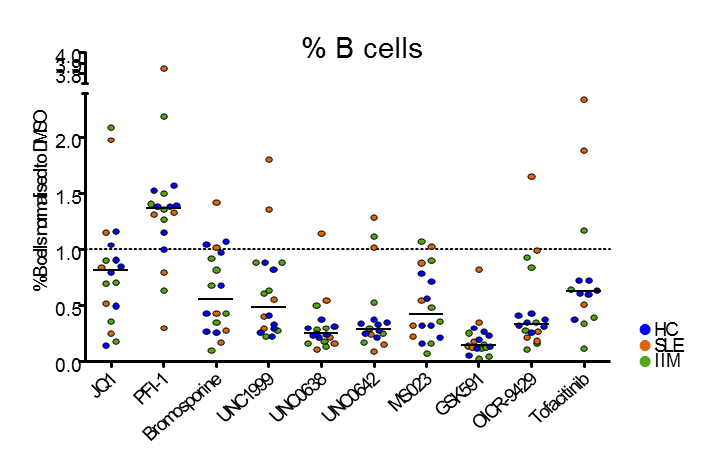 Fig 2b %B cells |
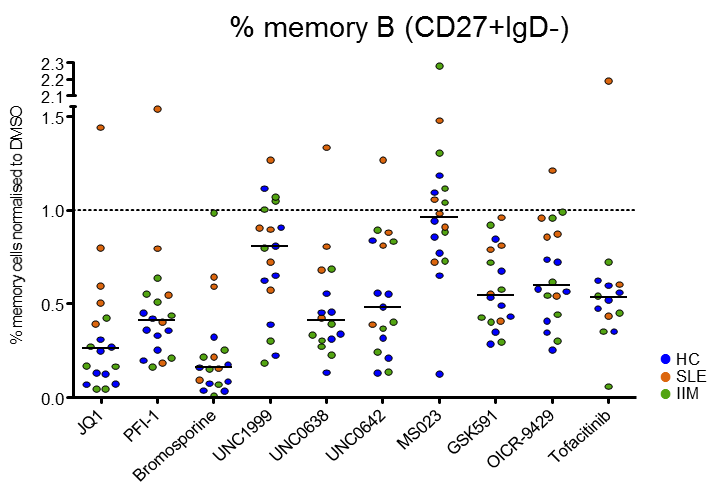 Fig 2c %memory B |
We have access to and tested negative control compounds* for five out of nine the selected chemical probes which displayed a significant effect in the assay. For GSK591/PRMT5, OICR-9429/WDR5 and JQ1/BET, the negative controls show no biological effect (Fig 3), indicating an on-target effect. However, results from UNC1999/EZH2 and UNC0638/G9a indicate that there may be off-target or scaffold effects of the active probe, since also the negative control compounds show biological effect (Fig 3).
* The chemical structure of a negative control is close to identical to the chemical probe itself, but it has significantly lower or non-measurable affinity for the primary target
In table 1, the effect of the 9 selected probes, including the effect on viability of leukocytes on day 6 of cell culture, is summarised. P-values are calculated by paired student’s t-test compared to vehicle control. ns=not significant. *viability is slightly increased compared to vehicle control.
|
Probe/chemical |
Target |
Target group |
Probe concentration |
Secreted IgG |
% B cells |
% memory cells of B cells |
% plasma cells of memory B cells |
% viable cells |
|
BET |
Bromodomains |
0,1 uM |
p<0,05 |
p<0,05 |
p<0,05 |
p<0,05 |
ns |
|
|
BET |
Bromodomains |
1 uM |
p<0,05 |
ns |
p<0,05 |
p<0,05 |
ns |
|
|
pan-BRD |
Bromodomains |
1 uM |
p<0,05 |
p<0,05 |
p<0,05 |
p<0,05 |
ns |
|
|
Histone Methyltransferase |
1 uM |
p<0,05 |
p<0,05 |
ns |
p<0,05 |
p<0,05* |
||
|
Histone Methyltransferase |
1 uM |
p<0,05 |
p<0,05 |
p<0,05 |
p<0,05 |
p<0,05* |
||
|
Histone Methyltransferase |
1 uM |
p<0,05 |
p<0,05 |
p<0,05 |
p<0,05 |
p<0,05* |
||
|
PRMT Type I |
Histone Methyltransferase |
1 uM |
p<0,05 |
p<0,05 |
ns |
ns |
ns |
|
|
Histone Methyltransferase |
1 uM |
p<0,05 |
p<0,05 |
p<0,05 |
p<0,05 |
p<0,05* |
||
|
WD40 (chromatin regulatory complex) |
1 uM |
p<0,05 |
p<0,05 |
p<0,05 |
p<0,05 |
ns |
||
|
Tofacitinib |
Jak1/3 |
|
1 uM |
ns (n=5) |
ns (n=6) |
p<0,05 |
ns (n=6) |
p<0,05* |
Table 1
Results Screen 2
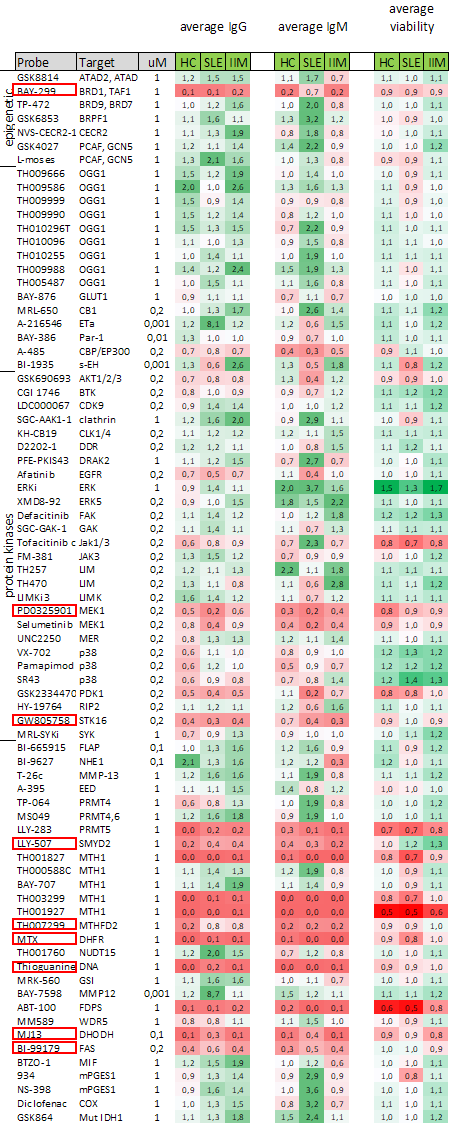
Fig 1
A set of 79 probes and compounds were tested in 18 blood donors including 5 patients with systemic lupus erythemtosus (SLE), 5 with idiopathic inflammatory myositis (IIM) and 8 healthy controls (HC). Due to limitations in cell numbers, each probe was tested in at least 11 blood donors (2-5 SLE, 2-5 IIM and 7-8 HC) The effect on PBMC IgG and IgM secretion and cell viability on day 6 of cell culture in presence of B cell stimulating agents are expressed normalized to the vehicle control (≤0,1% DMSO). Readouts have been averaged across donor groups. The compounds causing a reduction of IgG secretion by at least 50% without overt cytotoxicity are marked in red.
More information on the SGC chemical probes can be found here: http://www.thesgc.org/chemical-probes
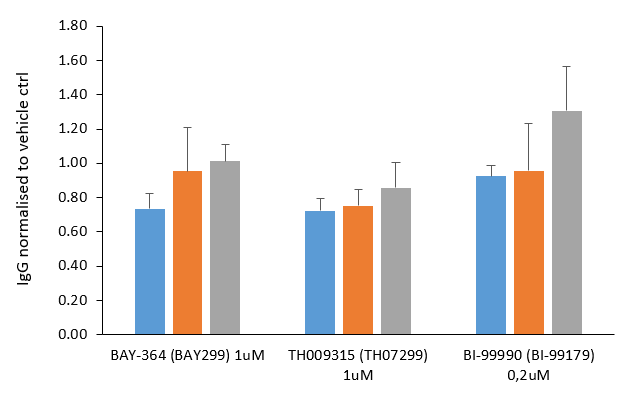
Fig 2
Of the 9 compounds selected in Fig 1, negative control compounds were available for BAY-299, TH07299 LLY-507 and BI-99179. These were tested and found to have little or no effect on induced IgG secretion. Data is shown as average normalised levels of IgG secretion + SD of biological triplicates from experiments performed on PBMC from three heatlhy controls.


Fig 3
Of the nine compounds selected in Fig 1, six were tested in dose-response curves. Data is shown as average absolute levels of IgG+SD from biological triplicates. Experiments were performed on PBMC from three heatlhy controls (same donors as in fig 2).







